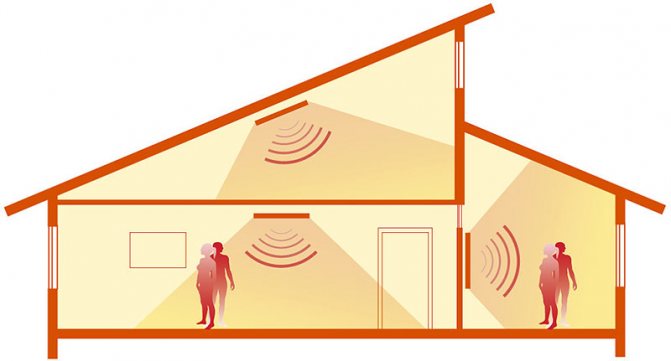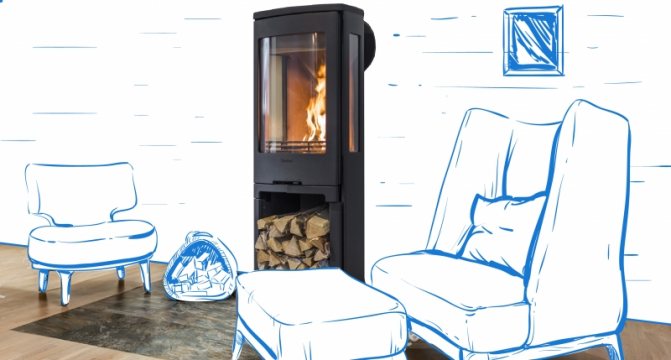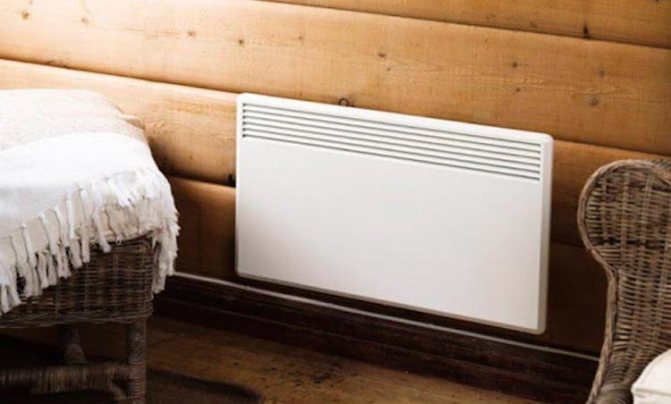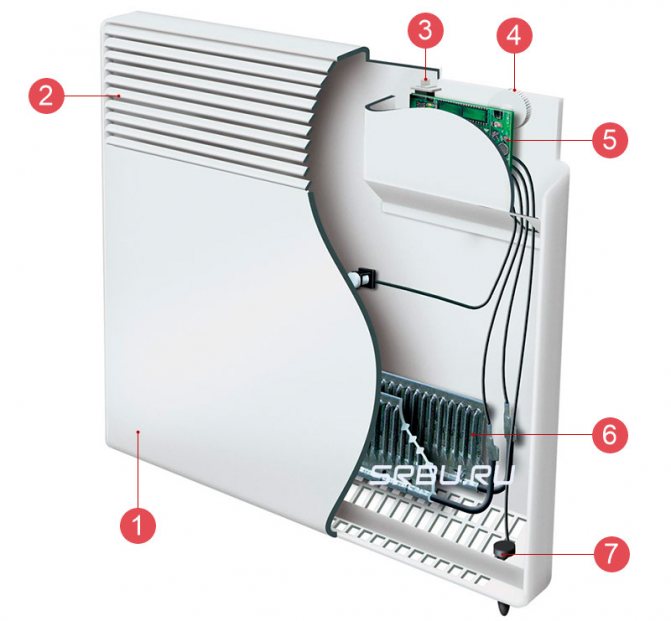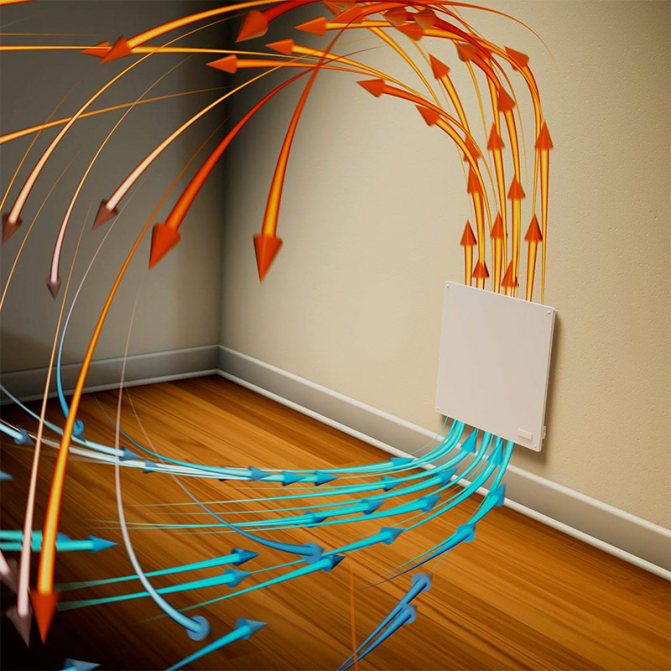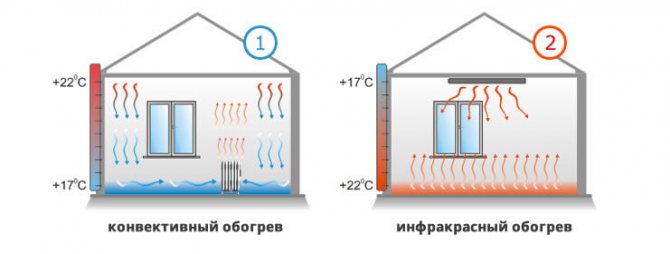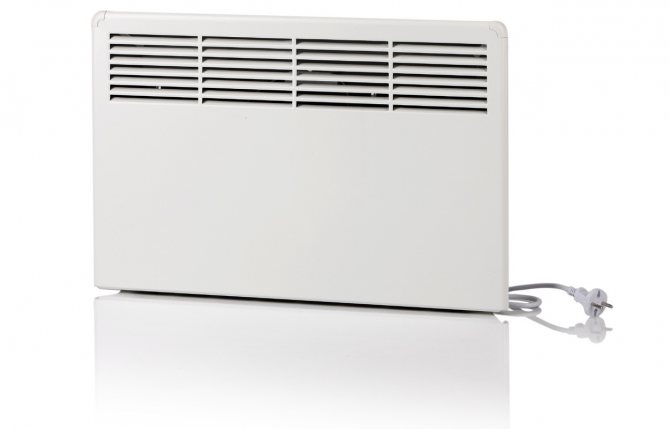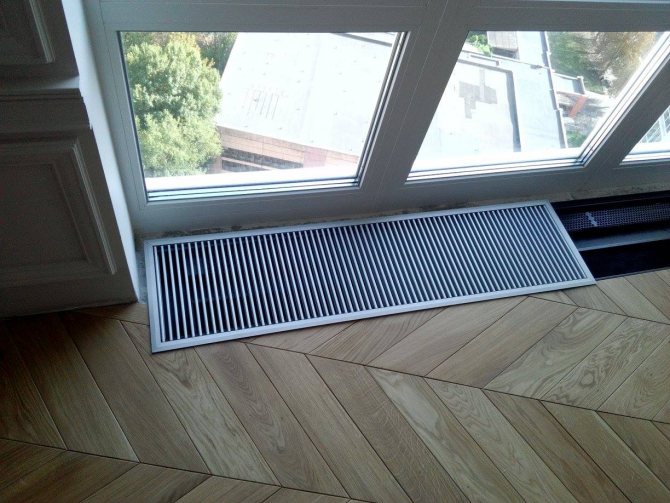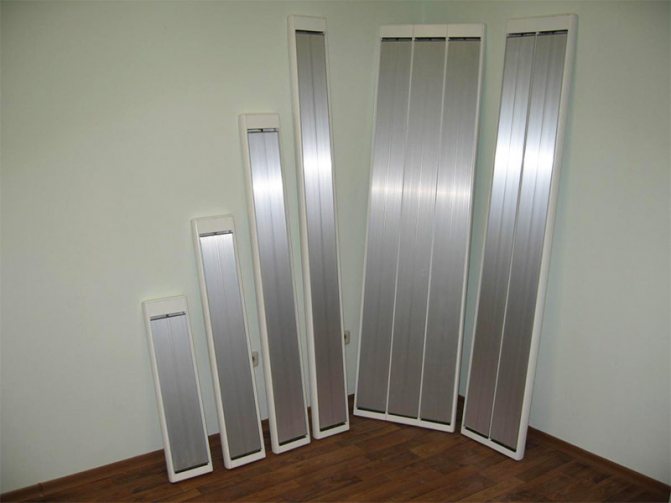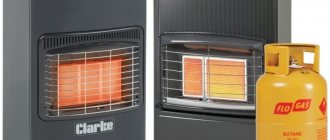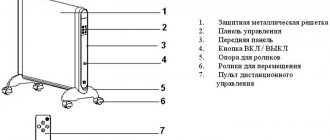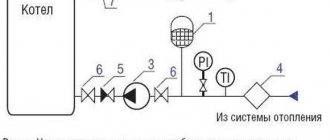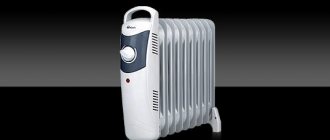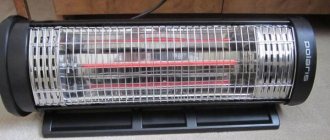
Infrared heaters are the most efficient space heating system today. This is due to the principle of infrared radiation, due to which not the air itself is heated, but the objects around. At the same time, heat loss is much lower than when the air is heated, since the objects around you retain heat.
The high efficiency and savings that infrared batteries provide are an important advantage. But the question remains that worries us no less.
The device and principle of operation of the electric convector
The electric convector is one of the most popular heaters used for heating domestic, industrial and office premises. Despite the rather wide popularity of this type of heater, few people have an idea of how it works, and what these or those convector controls are for.
The principle of operation of an electric convector is based on natural circulation (convection) of air. The convector, as a rule, has a rectangular shape, inside it is an electric heating element.
There are openings on the surface of the convector for air circulation. The convector is designed in such a way that the air coming from the bottom and side openings heats up after passing through the heating element and then exits through the openings located on the front panel of the convector.
For example, an oil-type heater heats a room due to heat radiation that comes from heated radiators. The convector has a different principle - the room is heated by a directed flow of heated air. Thanks to this, the convector heats the room much faster and, which is equally important, evenly over the entire area.


Air convection into the room
The heating element of a modern convector is low-temperature, it is made of a special alloy, due to which it heats up much faster than conventional tubular-type heating elements. As a rule, after 30 - 60 C ° after plugging into the network, the convector already begins to give off heat to the room.
The efficiency of this type of heater reaches 90% due to the fact that almost all the energy is spent on heating the room, unlike other types of heaters, for example, oil, which begins to give off heat to the room not immediately, but only after its heat-conducting medium warms up - oil, and then its metal case (radiator).
There is an opinion that heaters, including electric convectors, burn oxygen. But is it really so? As mentioned above, low-temperature heating elements are installed in the electric convector, the maximum heating temperature, as a rule, does not exceed 60 ° C.
At this temperature, oxygen is not burned, which is a significant advantage of the convector compared to other types of electric heaters, in which the heating elements are heated to several hundred degrees. In addition, the low operating temperature of the convector allows it to be installed almost everywhere, including near fire-hazardous surfaces, for example, on a wooden wall.
Here the question is pertinent, and how can a convector effectively heat a room if the operating temperature of its heating elements is much lower than in other types of heaters?
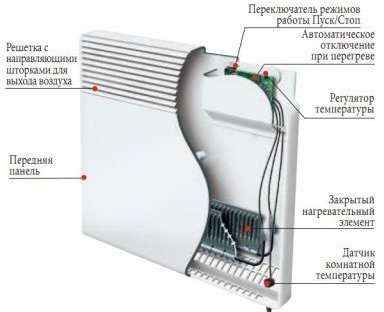

Electric convector device
The convector heating element is much larger than heating elements that have a higher operating temperature. Due to this, the convector generates a sufficient amount of heat and, despite the low operating temperature of its heating elements, is able to heat a large area.
Oil radiators
Attention: Among all types of heaters, oil heaters are considered the most reliable and safe. They consist of a sealed body filled with oil and an electric heating element. All modern models of such devices have a thermostat designed for manual control of the heating temperature of the device. High-end heaters are equipped with timers for heating programming and LCD displays that show the current operating parameters of the device. Models equipped with a built-in fan warm up the room faster and more evenly, accelerating the movement of convective currents and more intensively mixing layers of air with different temperatures in the room.
The body of the oil heater, depending on the type of unit, has the shape of a flat panel or a cast-iron central heating radiator - it consists of separate sections assembled into a battery. The more sections there are in such a device, the more intensively the room will be heated. The capacity of the radiators of various models of oil heaters can be different - it is possible to increase the heat transfer area of the battery by changing the profile of the sections while maintaining the basic dimensions of the unit.
This heating equipment has the following advantages:
- simplicity of design;
- noiselessness (models without a fan);
- affordable price;
- availability of automatic control;
- security.
Among the shortcomings, one can single out increased power consumption and a low speed of entering the operating mode - the result of the heater's operation will be felt no earlier than 30 minutes after turning it on. In addition, mention should be made of the rather significant weight of oil coolers - from 18 to 25 kg.
Types and features of thermostats
A thermostat is responsible for maintaining the desired temperature in the room in the convector design, which can be mechanically or electronically controlled. A mechanical thermostat reduces the cost of construction, but at the same time introduces some inconveniences in the process of using the device, in particular:
- poorly withstands temperature conditions
- consumes more electricity
- accompanies its work with characteristic clicks when switching on and off, which can be very annoying
An electronic thermostat significantly benefits from a mechanical one, it:
- completely silent
- maintains a given temperature value with a minimum error of one tenth of a degree
- reduces energy consumption within its limits
- makes it possible to carry out "climate control" remotely
- supports several operating modes - "comfort", "economy", "automatic", "anti-freeze".
Convectors with an electronic thermostat are more expensive than models with a mechanical one - but they are definitely worth it.
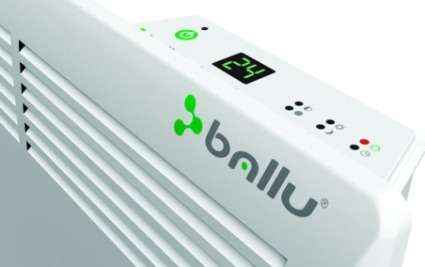

Electric convector with electronic thermostat
The presence of a thermostat and switches for heating elements allows you to regulate the temperature of heating the air in fairly wide ranges.
Infrared heaters
Infrared heaters are a fairly popular means of heating homes and other premises. They are sources of infrared radiation that can heat objects in the room that are exposed to infrared rays. Most often, such emitters are mounted on the ceiling or walls, but there are also portable tripod units.
Attention: With the help of these heaters, you can provide high-quality heating of the actual areas in the room. For example, it is possible to warm only a work or sleeping place, and the temperature in the rest of the room can be maintained without significant changes, which increases the efficiency of heating.
IR heaters have the following advantages:
- resistance to moisture;
- noiselessness;
- relatively low power consumption;
- a fairly wide range of power of manufactured devices;
- do not change the indicator of humidity in the room.
The distance from infrared heaters to the nearest object in the path of infrared rays in order to avoid a fire should be at least 2-3 meters. The room where the infrared heater is installed must be free of flammable objects (wool, paper, wood shavings).
What power to buy the device?
The average selection of the power of an electric heating convector can be made according to the following formula - 1 kW for every 10 square meters of area, provided that the height of the walls is no more than 2.7 meters. If this figure is higher, for each additional 10 centimeters of height, an additional 10% power is required.
You should also take into account the following points (if heating with convectors is the main one):
- For high-quality heating of convectors, as many as there are windows in the room.
- Corner rooms, rooms above a cold basement, or rooms with a large glass area clearly require equipment with sufficient power reserve.
These calculations should be enough for a preliminary estimate. For more details, you can check with the consultants in the store.
Non-electric heaters
All of the heaters listed above require electricity to operate. But in the absence of power supply, the need for heating does not disappear, and in such situations a gas convector is indispensable. Such devices are distinguished by heating efficiency, durability and reliability. Household gas, when burned, almost does not form harmful substances, so there is no need for an exhaust hood in the room. However, gas combustion is accompanied by the consumption of oxygen from the air, and the heated room must be periodically ventilated.
The gas convector is equipped with devices to automatically cut off the gas supply when the burner goes out (flame sensor), gas pressure surges in the supply or overturning of the device.
Infrared heaters operating on reduced gas (propane, butane) or diesel fuel (models with combustion products exhaust outside) have also proved to be excellent.
To heat the premises, you can also use more powerful devices - gas cannons, but they are used more often in industrial buildings, where people are not constantly present, periodically. However, even in such a situation, fire safety is a factor that occupies the first place in the requirements for the operation of such equipment.
Where is the best place to install the convector?
Before choosing an electric heating convector, it is imperative to determine its location. The devices can be installed on walls (using special fasteners included in the kit) or operated mobile, freely moving around the room or from room to room. If you are only interested in the second option, pay attention to whether there are wheels in the delivery set.
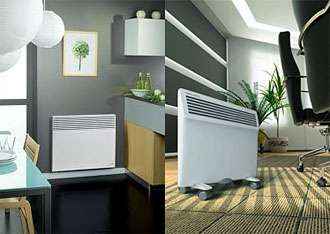

When buying, it is worth paying attention to the overall dimensions of the convector. Devices can have different heights and widths and look completely different in the interior - keep this in mind.
Types of heaters
Heating systems that are installed in suburban areas are, as a rule, ordinary fireplaces and stoves.But if it is not possible to constantly monitor the operation of such heaters and the country house is not used as a permanent residence, such devices are unsafe. What kind of heater to buy for a summer cottage if it is rarely visited? It is worth considering options such as:
- Oil;
- Fan heaters;
- Heat guns;
- Gas or electric convector;
- Infrared;
- Quartz;
- Electric fireplaces.
See also -
Which heater to choose for the garage
Frequently asked questions about electric convectors
Which convectors are more efficient - high or low?
The efficiency of the device does not depend on its size, but on the power. All kinds of "form factors" of equipment are created, first of all, for the convenience of its fitting into various interiors.
Is it dangerous to leave the convector unattended?
Definitely not. As long as your home's electrical wiring is capable of handling the combined power of concurrent appliances, you have nothing to worry about.
Can the convector be used as the main source of heating?
As a rule, yes. It all depends on the specific equipment model and manufacturer's recommendations.
Electric convector - a suitable choice for a children's room?


Quite. Among the products of most popular manufacturers there are units designed specifically for children's rooms - with a solid body, with streamlined shapes, without sharp corners. The holes in them are as small as it is, in principle, possible - all so that the child could not shove anything inside.
Electricity consumption
A question that worries everyone who uses a heater, especially on an ongoing basis, is the consumption of electricity by convectors. For simplicity in calculating electricity consumption, let's take a room with an area of forty square meters as an example.
- The total capacity of convectors for such a room is four thousand watts.
- The heater does not operate on a permanent basis, but periodically turns off when the set temperature is reached. In this mode, electricity consumption per day has a coefficient of about sixty percent.
- The calculation of electricity costs implies the following actions: divide 4000 by sixty percent. This equals 6.7 kWh.
- Calculating power consumption per day, provided an electronic thermostat, is not difficult. On average, the duration of the convector's operation per day will not exceed twelve hours. Multiplying 12 hours by 6.7 kW - we get 80.4 kW per day.
- The convector will consume 2412 kW per month. We multiply 80.4 kW by thirty - the average number of days in a month.
To read
Heat calculators SPT
We will make a reservation that the result obtained will be different in different rooms, since the indicators are influenced by the type of convector, the degree of insulation of the room, the likelihood of heat loss and other parameters.
User reviews and observations have shown that the convector is an excellent option for climate control technology for heating. It is safe, has high protection against fire, does not have a negative effect on the body.
Conclusions - what should you buy?
So, what is the best electric convector? Ideally, the device should have:
- monolithic or tubular heating element
- electronic thermostat
- protection against overheating, freezing
- sensor "deactivation" when rollover
- accessories for different installation options - both floor-standing and wall-mounted.
Optional, but very useful options can be a timer, remote control and display.
In conclusion, it should be said that electric convectors are a good choice for many reasons. Among their main advantages:
- No preparatory work required. No projects, permits, special conditions. Bought, brought, installed, connected
- Affordable cost. For $ 100-150 you can buy a mega unit
- Excellent efficiency.Almost all the electricity consumed by the convector is converted into heat energy.
Approaching the process of choosing an electric heating convector wisely, you are guaranteed to acquire a reliable unit that will heat you with high quality on long winter evenings. We wish you an extremely pleasant and useful shopping!
See also on this topic:
Indigirka, heating and cooking stove with a generator.
The warm floor is electric. Underfloor heating overview.
Which heater is more comfortable to use
Electric convectors are presented in two model options, based on the installation features. Wall-mounted models are attached to the wall at a height of 10-15 cm from the floor. Installation does not take much time. After fixing the device to the wall, it does not interfere with movement in the room or is conspicuous.
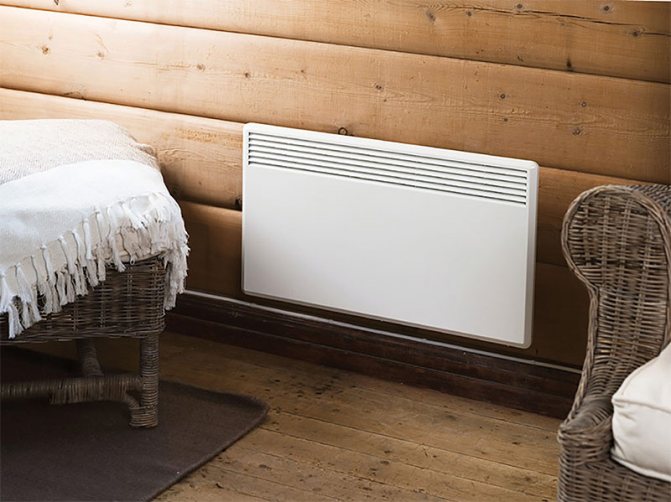

Floor-standing models are compact, equipped with casters or feet-stands. Due to its low weight and parameters, the device is easy to carry from one room to another. The presence of additional functions increases the ease of use.
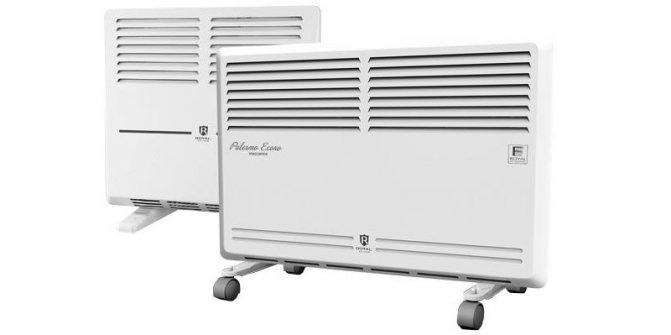

Infrared heaters are divided into mobile and stationary. Mobile models of infrared heaters can be easily moved within the room or carried to another room. However, the body of an infrared heater is often very hot, so you need to be careful when changing the orientation of the device or moving it to another room. Although the protective mesh protects from direct contact with the emitter, it has a rather high temperature.


As for stationary infrared heaters, they practically do not differ in this way from convector heaters. They are installed on walls or ceilings and do not cause any inconvenience to the inhabitants of the room.
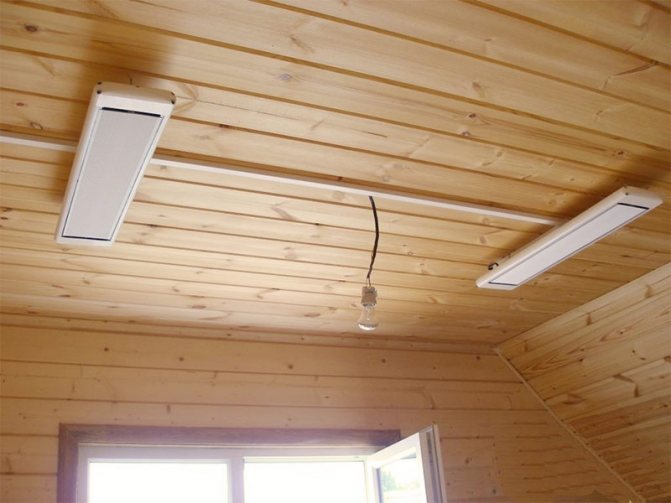

Convectors will be more comfortable to use. They do not require the same controls as infrared devices. The convector can be easily left unattended, while a powerful infrared heater can emit a large amount of heat, which can lead to negative consequences for both humans and nearby objects. Both devices are silent. However, users note that some models of infrared heaters emit a crackling sound when heated and cooled, caused by the thermal expansion of parts.
Is it possible to leave the switched on convector when no one is at home?
Generally speaking, you should not leave switched on electrical appliances in an empty house. Nevertheless, some convector models are equipped with such advanced control systems that make them completely safe to use in the absence of the owners. In addition to various emergency protective systems, the convector can be provided with automatic maintenance of the set temperature in the room. This allows you to minimize energy consumption and quickly heat it up after the arrival of people. A striking example of such a convector is the Electrolux Crystal ECH / G - 1000 E. It is equipped with an emergency system that cuts off the voltage if the device overheats or is damaged.



